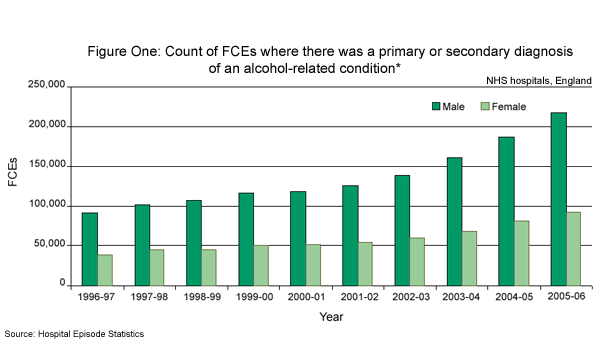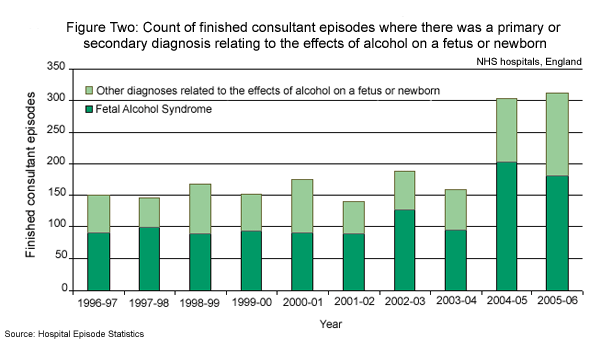IN THIS SITE...
Pregnant women and alcohol
The media attention surrounding women and alcohol consumption has recently increased dramatically. The general message seems to be that binge drinking is on the increase in women and that they are catching up or overtaking the male population in this area.
Current government advice states that women should not drink more than 2-3 units of alcohol per day. However, the popular image generated by the media of drunken young women would suggest that this advice is not taken as seriously as it should be.
The Department of Health suggests that people who become drunk or binge drink are much more likely to:
- be involved in an accident or assault
- be charged with a criminal offence
- contract a sexually transmitted disease
- have an unplanned pregnancy.
What do HES figures tell us about women's drinking habits?
Over the past 10 years, there has been a notable increase in alcohol-related finished consultant episodes (FCEs) for both sexes, although there were more for men than women (see figure one, below).
 |
Since 1996-97 the number of alcohol-related FCEs has actually increased at a very similar rate for men and women; 137% and 139% respectively. In both cases the increases were statistically significant; see related documents for a statistical analysis.
Alcohol and health: Focus on pregnancy
In May 2007, the government published new advice suggesting that women who are pregnant or trying to conceive should avoid alcohol altogether. This replaced previous advice that 1 or 2 units of alcohol per week are acceptable.
Why the need for the new advice?
Fetal Alcohol Syndrome (FAS), Q86.0 in ICD-10, and other alcohol-related birth defects refer to a group of physical and mental birth defects resulting from a woman drinking alcohol during pregnancy.
Physical characteristics of babies with FAS include:
- Small birth weight
- Epicanthal folds (skin that covers the inner corner of the eye)
- Flat mid face
- Underdeveloped jaw.
Consequences of the neurological damage that results from prenatal exposure to alcohol can include:
- Attention deficits
- Memory deficits
- Hyperactivity
- Poor problem-solving skills
- Difficulty learning from consequences
- Poor judgement
- Immature behaviour
- Poor impulse control.
The National Organisation on Fetal Alcohol Syndrome - UK (NOFAS - UK) reports that much of the research for western countries estimates that:
- 1 in 500 children are born with FAS
- 1 in 100 children are born with alcohol-related disorders from the spectrum (Fetal Alcohol Spectrum Disorder - FASD)
Combining these estimates with the ONS' reports of 700,000 live births in Britain each year, there are likely to be 6-7,000 babies born with FASDs of varying severity.
The number of finished consultant episodes (FCEs) recorded in HES for FAS is much lower than the estimates of the expected prevalence of the condition; we therefore recommend that Hospital Episode Statistics are not used to give an indication of the prevalence of FAS. This could be because many of the symptoms described above are often treated by GPs rather than in a hospital environment. In addition to this, FAS is notoriously difficult to diagnose because the physical characteristics are very similar to those of other conditions, such as Downs Syndrome.
There are also many social explanations as to why alcohol-related disorders are not commonly diagnosed within children. FAS and other related conditions are very sensitive issues for health care professionals to address with women who they suspect may be consuming, or have consumed, alcohol during pregnancy. Also, many women may be reluctant to admit to drinking alcohol if they believe it may have affected their babies. Again, this may have caused babies with conditions such as FAS to be wrongly diagnosed with more general learning disabilities.
Despite this, the number of finished consultant episodes for FAS has shown a clear increase in the two most recent data years. HES data also shows the number of FCEs where a fetus or newborn has been affected by their mother's intake of alcohol has more than doubled since 2003-04 (see figure two).This could reflect an increase in clinical awareness of such conditions or may be a result of a change in clinical coding practices within hospitals.
 |
The government recently announced a new voluntary agreement between ministers and the drinks industry which will see alcoholic drinks carrying new labels with health warnings by the end of 2008. The labels will give advice on the recommended maximum number of units for men and women and also warn pregnant women not to drink.
Defining 'Alcohol related'
Unfortunately, the definition of an alcohol-related diagnosis is not clear cut. Alcohol can be a contributory factor in hundreds of conditions but is the sole cause of very few. The most popular diagnoses which are defined as 'alcohol related' are:
- T51 toxic effect of alcohol
- F10 mental and behavioural disorders due to use of alcohol
- K70 alcoholic liver disease.
However, there are a wider group of less common diagnoses, which include very specific conditions caused by alcohol.
For the purpose of this analysis, alcohol-related finished consultant episodes were defined using the following ICD-10 diagnosis codes:
- E24.4 Alcohol-induced pseudo-Cushing's syndrome
- F10.- Mental and behavioural disorders due to use of alcohol
- G31.2 Degeneration of nervous system due to alcohol
- G62.1 Alcoholic polyneuropathy
- G72.1 Alcoholic myopathy
- I42.6 Alcoholic cardiomyopathy
- K29.2 Alcoholic gastritis
- K86.0 Alcohol-induced chronic pancreatitis
- K70.- Alcoholic liver disease
- T51.- Toxic effect of alcohol
- Z50.2 Alcohol rehabilitation
- Z71.4 Alcohol abuse counselling and surveillance
- Z72.1 Alcohol use
ICD-10 diagnosis codes which relate to the effects of alcohol on a foetus or newborn:
- O35.4 Maternal care for (suspected) damage to foetus from alcohol
- P04.3 Foetus and newborn affected by maternal use of alcohol
- Q86.0 Foetal alcohol syndrome (dysmorphic)
Assessing growth through time
HES figures are available from 1989-90 onwards. During the years that these records have been collected by the NHS there have been ongoing improvements in quality and coverage. These improvements in information submitted by the NHS have been particularly marked in the earlier years and need to be borne in mind when analysing time series.
In addition to this, the number of secondary diagnosis fields increased to 14 in 2002-03, up until this point a patient could only have a total of 6 secondary diagnoses for their hospital episode. Some of the increase in alcohol-related admissions could therefore be attributable to the fact that doctors were simply able to record more information post 2002-03.


